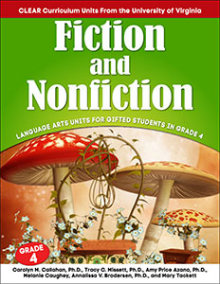Differentiated Fiction and Nonfiction Lessons
Fiction and Nonfiction: Language Arts Units for Gifted Students in Grade 4
By Amy Price Azano, Tracy C. Missett and Carolyn M. Callahan, CLEAR series editor
(Prufrock Press, 2017 – Learn more)

The focus for this book is on CLEAR Curriculum: (Continual Formative Assessment, Clear Learning Goals, Data-Driven Learning Experiences, Authentic Products, and Rich Curriculum), their acronym for a process to design (or redesign) classroom curriculum and create easier, richer, and more meaningful assignments and assessments for students. This book definitely delivers on its promise.

Meeting the below reading-level challenge
As many are aware, a large percentage of our students come to the middle school grades reading below their grade level so finding a curriculum set that allows for easier scaffolding and modification is a blessing. Simply put, there is no feasible way to begin middle school lessons at an expected range for students when their test scores and assessed abilities place them in the middle elementary grades at the beginning of the year.
The authors’ belief is that students will be able to grow along with the curriculum as they face assignments throughout the year that are both more challenging and properly scaffolded. It’s also notable that Fiction and Nonfiction: Language Arts Units for Gifted Students in Grade 4 is one of several CLEAR books from Prufrock Press and the University of Virginia (see 5th grade volume) with the goal of giving teachers what they need to design a more effective classroom system while also keeping students engaged in their learning.
Lessons filled with core language arts skills
Azano and Missett include complete unit plans and detailed lessons that focus on core language arts skills students often lack. For example, Part II begins with a “Welcome to Fiction” and then focuses student attention more closely to skills such as setting, characterization, point of view, etc.
Each annotated lesson is marked with key illustrations, which focus the instruction even further, and there are guideposts to illustrate how a teacher may differentiate the lesson, if needed. An educator might simply glance at the lesson plan and see what each instructional piece or set-up needs for a given activity based solely on the images.
There are helpful, simple, mindful definitions of key terms at the beginning of each unit, so making copies for students is not a hassle. A great time-saving idea is to print the “objectives” lists as anchor charts, which saves a lot of precious planning time while giving the students a guide for the classroom.
The units each have their own outline detailing the expected lesson length and the skills and objectives taught. This chart makes unit planning and creating a calendar a breeze.
Help with assessment
Each unit has a pre-prepared, pre-unit assessment which can gauge where students currently are with the skill levels. If students assess well, the class may then progress to the next skill. Each unit also contains a plethora of amazing handouts in student-friendly language. These worksheets function like formative assessments themselves, or even exit tickets.
Several of the units/lessons have reading passages already, and the focus skills vary based upon targeted instruction. Because the readings are already child-friendly and challenging, the assignment can assess more. The readings for each unit are very engaging and full of difficult-to-master skills, such as inferencing and conflict.
This book is well worth the cost and great for those teachers who want to challenge their fourth or fifth graders or for middle school teachers looking for a way to bridge the gap from where students are to where they need to be.
Erin Corrigan-Smith is a middle school ELA teacher in a suburb of Atlanta. She has a B.A. and M.A. in English, and her focus of study is children’s literature. During the school year, she is faculty advisor to the cooking club and drama club. In her downtime, she enjoys going to her family’s cabin in the North Georgia Mountains with her husband and dog to read and relax.






























